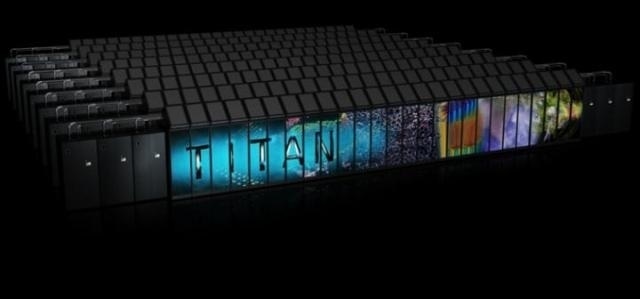Mar 18 2016
Heterostructures (referred to as Van der Waals {VdW}) are attracting a great deal of attention due to their diverse physical and chemical properties. A VdW heterostructure is assembled by stacking two or more different 2D semiconducting crystals on top of each other.
 The supercomputer 'Titan' can possibly give a glimpse into the future of highly sensitive electronic information transmitting and processing devices based on spin-memory. Credit: IBS
The supercomputer 'Titan' can possibly give a glimpse into the future of highly sensitive electronic information transmitting and processing devices based on spin-memory. Credit: IBS
The structure is grown by repeating the practice, the resulting stack represents an artificial material constructed in a certain sequence, akin to Lego blocks. There has been huge interest in these materials as they hold vast potential in helping science to find a new semiconductor that can replace silicon which decomposes and segregates in a natural environment. A VdW heterostructure can overcome the limitations of 2D crystals and offer an alternative for the construction of smaller and more powerful storage devices, supercomputers, administration of medicine and enhanced memory and graphics in hand held devices. Electrons within semiconductors roam freely and have internal states or 'spins'. These spin currents exhibit magnetic order and can be tuned to prevent energy dissipation which occurs naturally when information is processed at vast speeds. However, not all VdW's have this spin state; scientifically known as an antiferromagnetic state. PARK Je-Geun, a scientist from CCES, explains the unique qualities of their tested material NiPS3: "The compound nickel phosphorus trisulfide (NiPS3) is an intrinsically magnetic material and is an invaluable building block for the design for multi-layered VdW heterostructures." The Center is the first to obtain monolayer and multilayer samples of magnetic VdW materials; the results lay the foundation for the development of future semiconductors that are high speed, low energy consuming and highly compact.
World's first in Korea
The VdW material the IBS team experimented on belongs to a class of transition metals phosphorus trisulfides (MPS3) and, more importantly, exhibits antiferromagnetic order. With further developments, it can, theoretically, replace silicon as an ideal material for future magnetic semiconductors. The results compiled by the IBS team have never before been reported in the form of ultrathin sheets. The team's scientific paper, published on February 15 in Scientific Reports, outlined the potential of their work as such: "Beyond their already fascinating properties, these VdW heterostructures and superlattices may exhibit even more exotic behavior. In particular, for the design of spintronic devices, VdW materials that exhibit magnetic order would be highly desirable building blocks."
Methods of CCES & A Bright Future for 2D Materials
Using the well-established Scotch tape technique, the Korean team exfoliated flakes of NiPS3 onto silicon capped by silicon oxide (SiO2). The resulting material was subjected to a heavy bombardment of high intensity lasers: a process called Raman spectroscopy, designed to provide specific information about molecular vibrations. Other forms of atomic scanning were performed to ascertain how different the atomic make-up of NiPS3 is, in comparison, to its bulk form: MPS3. The team recorded stark differences in the Raman spectra of thin NiPS3 from the bulk material and the Raman spectra varied clearly between sheets of different layer numbers. According to the paper these results exhibit a "key significance of our results is that bulk MPS3 compounds exhibit magnetism, and antiferromagnetic ordering strongly influenced by interlayer coupling is known to take place at moderately low temperature." Up until now, it is quite expensive to obtain magnetic monolayer oxides materials as it requires a high-end device and the material itself is less likely to be commercially available for technical use. This study proves that monolayer magnetic material can be obtained using magnetic atom like nickel (Ni) as well as many other magnetic atoms such as iron (Fe). The work of the IBS team is, tentatively, laying the foundations for the future study of spin-memory materials. Research is continuously driven by our collective scientific curiosity; we are within reach of precise control of electrons and atoms which would herald a new era of scientific exploration. The research team's next mission is to obtain a magnetic monolayer material at moderate temperature. If they succeed, it will be very crucial step in commercializing magnetic semiconductors.